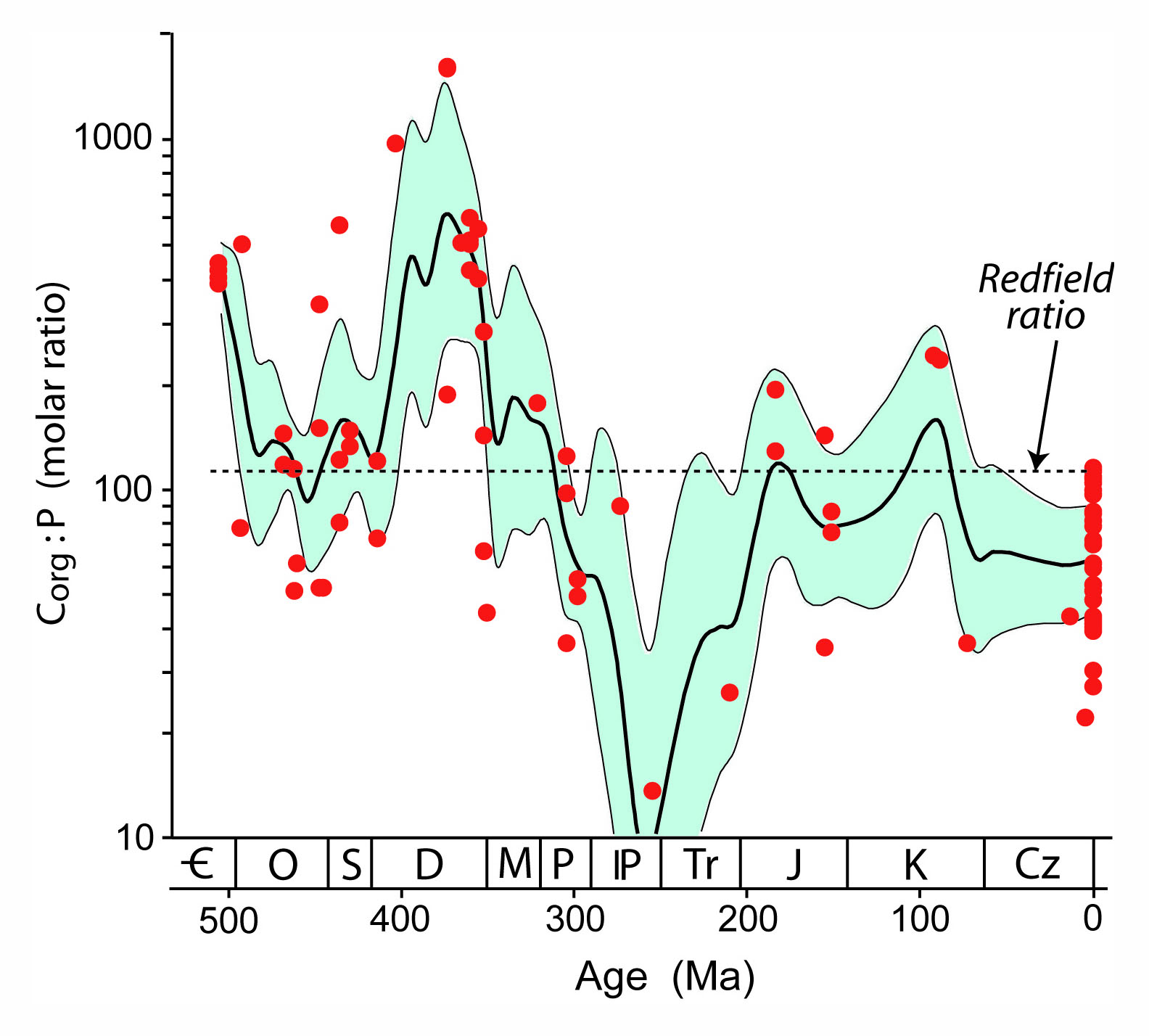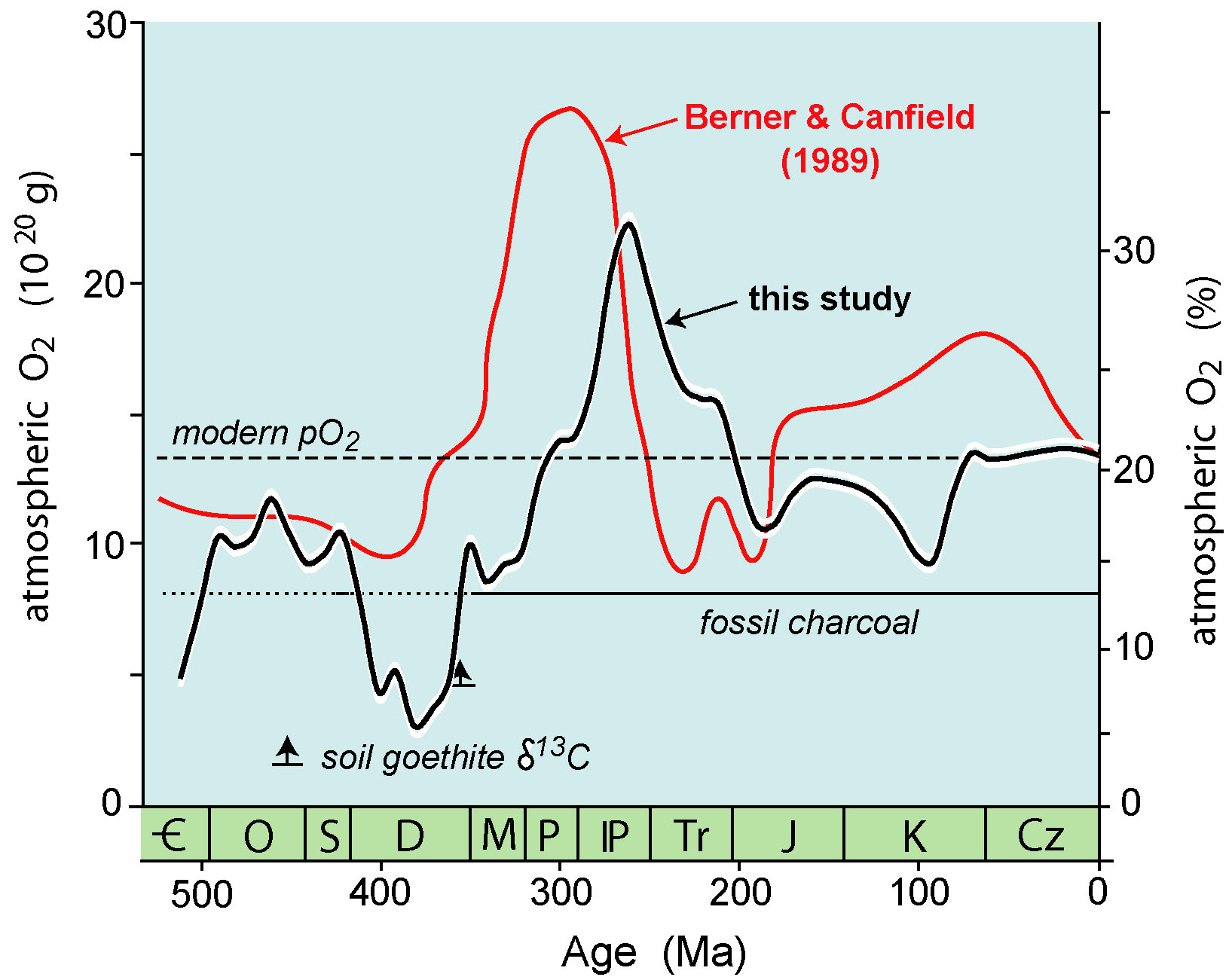|
RESEARCH
Thomas
J. Algeo
Professor
of Geology
University
of Cincinnati
|
|
| Long-term
Co-Evolution
of Earth systems
The Earth’s
chemical, physical, and biological systems have evolved in tandem, with
important feedbacks among them. Many such relationships have
received scant attention to date but are amenable to study through
analysis of long-term variation in geochemical proxies.
For example, marine sediment Corg:P ratios have varied systematically
through the Phanerozoic, rising during the Carboniferous and
Cretaceous and falling during the mid-Paleozoic and the Permian-Triassic
(right; Algeo and Ingall, 2007). Although Corg:P ratios are
influenced by local factors (e.g., organic matter origin and diagenetic
history, watermass circulation and ventilation), the strong pattern of
secular variation seen in this figure reflects the operation of a global
control. This global control is likely to be atmospheric pO2,
which correlates with the concentration of dissolved O2 in the
surface waters of lakes and oceans, other factors being equal. More oxic bottomwater conditions result in loss of organic C (through
oxidation) but retention of P (through adsorption on FeOOH compounds),
while the opposite pattern pertains to anoxic bottomwater
conditions.
|

|
| The Phanerozoic marine
Corg:P record (above) can be empirically converted to an atmospheric pO2
record (right; Algeo and Ingall, 2007). We infer that pO2
levels were low in the Early Paleozoic but began rising sharply in the
mid-Devonian, peaking at ~1.5X PAL (present atmospheric level) during the
Permian. This pattern is similar to that based on the C-cycle model
of Berner and Canfield (1989). The principal differences are that
the Corg:P proxy record implies (1) lower pO2 during the
mid-Paleozoic, and (2) a later and somewhat smaller peak in pO2
during the Late Paleozoic. The absence of fossil charcoal prior to
the Late Devonian, and its abundance since that time (Algeo and Ingall,
2007), are evidence in support of a rapid rise in pO2 during
the Late Devonian. These results have important
implications for long-term controls on (and stability of) Earth-surface
redox conditions. |

|
|
IN REVIEW
|
Marine sediments exhibit systematic
variation in δ15N through the Phanerozoic (left), rising
during the Carboniferous and Cenozoic and falling during the mid-Paleozoic
and Jurassic-Cretaceous (Algeo et al., 2012, in review). This
pattern reveals a strong correlation to first-order climate variation
(bottom of figure), with higher δ15N during icehouse
climate modes and lower δ15N
during greenhouse climate modes. This pattern is probably controlled
by paired rates of water-column denitrification and cyanobacterial N
fixation. Higher rates are associated with icehouse climate modes
owing to a general invigoration of ocean circulation, resulting in higher
rates of marine productivity and fixed N utilization. Because of the
importance of N for marine productivity, large changes in inferred rates
of N fixation and denitrification through the Phanerozoic may reflect a
major role for N in feedbacks within the global climate system. |
References
Algeo, T.J., and
Ingall, E.D., 2007, Sedimentary Corg:P ratios, paleocean ventilation,
and Phanerozoic atmospheric pO2: Palaeogeography
Palaeoclimatology Palaeoecology, v. 256, p. 130-155,
doi:10.1016/j.palaeo.2007.02.029.
Algeo, T.J., Meyers, P.A., Rowe, H., Jiang, G. Tectonic and
climatic controls on the Phanerozoic marine nitrogen cycle. Manuscript, Sept.
2012.
Berner,
R.A., Canfield, D.E., 1989. A new model for atmospheric oxygen over Phanerozoic
time. Am. J. Sci. 289, 333-361.
Last
updated 17 Sept 2012
Back
to Research Page
Back
to Homepage
